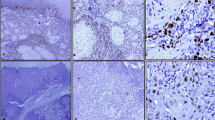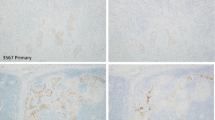Abstract
Purpose
Determination of marker for identification of oral squamous cell carcinoma (OSCC) is important for early diagnosis and individual therapy. Cytokeratins (CKs) like CK 19 and CK 20 are known to be useful diagnostic and prognostic markers for solid tumors. The aim of this study was to evaluate the relevance of further CKs for diagnosis of OSCC.
Materials
In 10 OSCC and 5 normal mucosal samples, the expression patterns of 31 CK genes were examined by cDNA microarray in order to identify CKs with most pronounced over-expression. The results were verified for CK 17, CK 19, and CK 20 in addition to 46 OSCC samples by relative quantification (RQ) using SYBR green real-time reverse transcriptase polymerase chain reaction (RT qPCR). A correlation of the CK expressions with the tumor classification was carried out.
Results
cDNA microarray analyses showed that out of all CKs, CK 17 was up-regulated strongest in OSCC compared to normal samples, and over-expression was most significantly associated with diagnosis (P = 0.002). Expression rates of CK 19 and CK 20 were not significantly different between OSCC samples and normal samples. In 56 samples analyzed by real-time RT qPCR, CK 17 was over-expressed in 53 (94.6%), CK 19 in 18 (32.1%), and CK 20 in 7 (12.5%). The over-expression of CK 17 was significantly associated with metastases of neck lymph nodes (P < 0.05). CK 19 was significantly over-expressed in T3 and T4 OSCC, in stage III and IV patients (P < 0.05), and in poorly differentiated OSCC (P < 0.03). The over-expression of CK 20 was significantly associated with metastases of neck lymph nodes (P < 0.03). Determined by RQ, the mean value of CK 17 over-expression was significantly higher than that of the other CKs (P < 0.01), and was significantly associated with T1 and T2 OSCC (P < 0.03) and with stage I and II patients (P < 0.01).
Conclusion
CK 19 might be linked to the clinical progression and differentiation of OSCC, and CK 20 could be associated with metastases of neck lymph nodes in OSCC. Due to the significant up-regulation and the strong over-expression, CK 17 might be the most suitable marker for diagnosis of OSCC out of the CK-family.





Similar content being viewed by others
References
Beger HG, Rau B, Gansauge F, Poch B, Link KH (2003) Treatment of pancreatic cancer: challenge of the facts. World J Surg 27:1075–1084
Carrilho C, Alberto M, Buane L, David L (2004) Keratins 8, 10, 13, and 17 are useful markers in the diagnosis of human cervix carcinomas. Hum Pathol 35:546–551
Christoph F, Weikert S, Wolff I, Schostak M, Tabiti K, Muller M, Miller K, Schrader M (2007) Urinary cytokeratin 20 mRNA expression has the potential to predict recurrence in superficial transitional cell carcinoma of the bladder. Cancer Lett 245:121–126
Chu PG, Schwarz RE, Lau SK, Yen Y, Weiss LM (2005) Immunohistochemical staining in the diagnosis of pancreatobiliary and ampulla of Vater adenocarcinoma: application of CDX2, CK17, MUC1, and MUC2. Am J Surg Pathol 29:359–367
Cohen-Kerem R, Madah W, Sabo E, Rahat MA, Greenberg E, Elmalah I (2004) Cytokeratin-17 as a potential marker for squamous cell carcinoma of the larynx. Ann Otol Rhinol Laryngol 113:821–827
Elsheikh MN, Mahfouz ME, Elsheikh E (2005) Level IIb lymph nodes metastasis in elective supraomohyoid neck dissection for oral cavity squamous cell carcinoma: a molecular-based study. Laryngoscope 115:1636–1640
Garrel R, Dromard M, Costes V, Barbotte E, Comte F, Gardiner Q, Cartier C, Makeieff M, Crampette L, Guerrier B, Boulle N (2006) The diagnostic accuracy of reverse transcription-PCR quantification of cytokeratin mRNA in the detection of sentinel lymph node invasion in oral and oropharyngeal squamous cell carcinoma: a comparison with immunohistochemistry. Clin Cancer Res 12:2498–2505
Goldstein NS, Bassi D (2001) Cytokeratins 7, 17, and 20 reactivity in pancreatic and ampulla of vater adenocarcinomas. Percentage of positivity and distribution is affected by the cut-point threshold. Am J Clin Pathol 115:695–702
Hamakawa H, Bao Y, Takarada M, Fukuyumi M, Tanioka H (1998) Cytokeratin expression in squamous cell carcinoma of the lung and oral cavity: an immunohistochemical study with possible clinical relevance. Oral Surg Oral Med Oral Pathol Oral Radiol Endod 85:438–443
Hashimoto T, Kobayashi Y, Ishikawa Y, Tsuchiya S, Okumura S, Nakagawa K, Tokuchi Y, Hayashi M, Nishida K, Hayashi S, Hayashi J, Tsuchiya E (2002) Prognostic value of genetically diagnosed lymph node micrometastasis in non-small cell lung carcinoma cases. Cancer Res 60:6472–6478
Hsiao LL, Dangond F, Yoshida T, Hong R, Jensen RV, Misra J, Dillon W, Lee KF, Clark KE, Haverty P, Weng Z, Mutter GL, Frosch MP, Macdonald ME, Milford EL, Crum CP, Bueno R, Pratt RE, Mahadevappa M, Warrington JA, Stephanopoulos G, Stephanopoulos G, Gullans SR (2001) A compendium of gene expression in normal human tissues. Physiol Genomics 7:97–104
Kawamata H, Uchida D, Nakashiro K, Hino S, Omotehara F, Yoshida H, Sato M (1999) Haematogenous cytokeratin 20 mRNA as a predictive marker for recurrence in oral cancer patients. Br J Cancer 80:448–452
Kijima F, Natsugoe S, Takao S, Aridome K, Baba M, Yoshifumi M, Eizuru Y, Aikou T (2000) Detection and clinical significance of lymph node micrometastasis determined by reverse transcription-polymerase chain reaction in patients with esophageal carcinoma. Oncology 58:38–44
Kubota K, Nakanishi H, Hiki N, Shimizu N, Tsuji E, Yamaguchi H, Mafune K, Tange T, Tatematsu M, Kaminishi M (2003) Quantitative detection of micrometastases in the lymph nodes of gastric cancer patients with real-time RT-PCR: a comparative study with immunohistochemistry. Int J Cancer 105:136–143
Liefers GJ, Cleton-Jansen AM, van de Velde CJ, Hermans J, van Krieken JH, Cornelisse CJ, Tollenaar RA (1998) Micrometastases and survival in stage II colorectal cancer. N Engl J Med 339:223–228
Lindberg K, Rheinwald JG (1989) Suprabasal 40 kd keratin (K19) expression as an immunohistologic marker of premalignancy in oral epithelium. Am J Pathol 134:89–98
Maddox P, Sasieni P, Szarewski A, Anderson M, Hanby A (1999) Differential expression of keratins 10, 17, and 19 in normal cervical epithelium, cervical intraepithelial neoplasia, and cervical carcinoma. J Clin Pathol 52:41–46
Martens J, Baars J, Smedts F, Holterheus M, Kok MJ, Vooijs P, Ramaekers F (1999) Can keratin 8 and 17 immunohistochemistry be of diagnostic value in cervical cytology? A feasibility study. Cancer 87:87–92
Mohr C (1997) Report on the 27th annual meeting of the German-Austrian-Swiss Working Group for tumors of the maxillofacial area. Mund Kiefer Gesichtschir 1:125–126
Moll R, Zimbelmann R, Goldschmidt MD, Keith M, Laufer J, Kasper M, Koch PJ, Franke WW (1993) The human gene encoding cytokeratin 20 and its expression during fetal development and in gastrointestinal carcinomas. Differentiation 53:75–93
Okada Y, Fujiwara Y, Yamamoto H, Sugita Y, Yasuda T, Doki Y, Tamura S, Yano M, Shiozaki H, Matsuura N, Monden M (2001) Genetic detection of lymph node micrometastases in patients with gastric carcinoma by multiple-marker reverse transcriptase-polymerase chain reaction assay. Cancer 92:2056–2064
Ram Prassad VV, Nirmala NR, Kotian MS (2005) Immunohistochemical evaluation of expression of cytokeratin 19 in different histological grades of leukoplakia and oral squamous cell carcinoma. Indian J Dent Res 16:6–11
Roepman P, Wessels LF, Kettelarij N, Kemmeren P, Miles AJ, Lijnzaad P, Tilanus MG, Koole R, Hordijk GJ, van der Vliet PC, Reinders MJ, Slootweg PJ, Holstege FC (2005) An expression profile for diagnosis of lymph node metastases from primary head and neck squamous cell carcinomas. Nat Genet 37:182–186
Smedts F, Ramaekers F, Troyanovsky S, Pruszczynski M, Link M, Lane B, Leigh I, Schijf C, Vooijs P (1992) Keratin expression in cervical cancer. Am J Pathol 141:497–511
Soeth E, Grigoleit U, Moellmann B, Roder C, Schniewind B, Kremer B, Kalthoff H, Vogel I (2005) Detection of tumor cell dissemination in pancreatic ductal carcinoma patients by CK 20 RT-PCR indicates poor survival. J Cancer Res Clin Oncol 131:669–676
van de Rijn M, Perou CM, Tibshirani R, Haas P, Kallioniemi O, Kononen J, Torhorst J, Sauter G, Zuber M, Kochli OR, Mross F, Dieterich H, Seitz R, Ross D, Botstein D, Brown P (2002) Expression of cytokeratins 17 and 5 identifies a group of breast carcinomas with poor clinical outcome. Am J Pathol 161:1991–1996
Zhong LP, Chen WT, Zhang CP, Zhang ZY (2007) Increased CK19 expression correlated with pathologic differentiation grade and prognosis in oral squamous cell carcinoma patients. Oral Surg Oral Med Oral Pathol Oral Radiol Endod 104:377–384
Acknowledgment
This study was supported by a grant of the Johannes und Frieda Marohn Stiftung Erlangen.
Author information
Authors and Affiliations
Corresponding author
Additional information
An erratum to this article can be found at http://dx.doi.org/10.1007/s00432-007-0350-6
Rights and permissions
About this article
Cite this article
Toyoshima, T., Vairaktaris, E., Nkenke, E. et al. Cytokeratin 17 mRNA expression has potential for diagnostic marker of oral squamous cell carcinoma. J Cancer Res Clin Oncol 134, 515–521 (2008). https://doi.org/10.1007/s00432-007-0308-8
Received:
Accepted:
Published:
Issue Date:
DOI: https://doi.org/10.1007/s00432-007-0308-8




